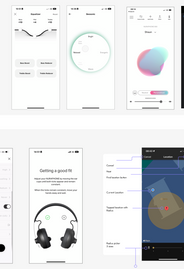DYSON UK - 2022
B2C Audio & Air quality protection app design
Context
As a Product Designer at Dyson for 1 year, I worked on the next generation of the headphone 'Zone' launched in 03.2023. This product had multiple embedded sensors, and has the objective of protecting the user of both the surrounding pollution (using a mounted airflow visor) and any dangerous sounds/noises (using ANC technology).
I worked on re-imagining a coherent 'user protection' product vision, building a new mobile app that puts user's health and exposure targets at the heart of it, using user feedback of the current product version.
What is it?
It is a connected air-cleaning headphone and a companion app:
-
The mobile app: It provides a visual representation and control over the smart protection against Air quality and dangerous sound level in any circumstances (while running, walking, working, commuting..). It also provides historical trends and data insights on how and where did the user got exposed to these threats, and how much of it got eliminated.
-
The air-cleaning connected headphone: It protects the user of Air quality and dangerous sound level threats in any circumstances (while running, walking, working, commuting..) by automatically adjusting the level of ANC (noise cancellation) and visor airflow depending on the measured surrounding threat level.
How does it work?
It uses the data measured live by the headphone to interface it in a smart & interesting way to the user. External city-level pollution and weather data are also used to provide more context and smarter automated features.
10
Competitor tested
3
App concepts
4mth
Diary Study
35+
User interviews
6mth
Project

Process
Problem
-
Current Dyson Zone headphone HMI & Mobile app didn't trialed very well, and are the results of complicated 6 years of development that made the core product solution lost its main objectives
-
Goal was to re-build a clearer solution from scratch out of the existing technology, and define clear product objectives and release roadmap for the category.
Understand competition
-
I ran a survey to 200+ headphone users to understand which brand they own and how they use it. I mapped out 3 Main types of headphones usage, each having their own HMI controls & feature set:
-
Workout
-
Commuting/outdoor
-
Desk-headphones
-
-
I mapped 10 competitors headphones HMI, companion app screens & Smart AQ mask products
-
I ran an intensive 4 months diary study test, with 7 participants testing 5 competitor headphones and mobile apps, 1 week each:
-
Apple Airpods Max won the trial, with some loved automated features & very easy HMI
-
Sony Mobile app didn't trial well, because of the overwhelming complexity of its UI and feature-set
-
-
Using these insights, I built a product feature user need map for both hardware & mobile
-
Required mobile features:
-
One tap set-up
-
Changing audio source in-app
-
Provide ANC level control
-
Custom EQ tune & creation
-
-
HMI enhancement opportunities:
-
Scrolling wheels are the best premium sound level input
-
1 button quick access on/off ANC
-
Head-detect auto-music pause
-
On/Off button is needed on top of the head-detect
-
-
Set a product vision
-
I set a series of 'UX rules' that the ideal product should follow, all following the key product vision. Goal was to ignore any engineering requirements and simply understand what would be 5/10+ year product end-goal.
-
This created an ideal feature list/actionnable solutions for the headphone itself, for the mobile app itself, and for both combined when connected to each other, ranked from MVP to ideal solution
-
I set custom Product Personas, in collaboration with group Commercial: Active citizens, AQ sensitive, Family carer, Tech collector
-
I built a 'Day in life' user need & feature opportunities matrix for each Persona
Build a new Mobile app proposal
Using all the gathered data and user feedback, I designed multiple variations of mobile app IA & feature-set, ready to be user tested
Home page feature set:
-
Battery percentage & airflow remaining usage
-
Airflow fan speed control:
-
Contextual information > Is the user protected from the Air quality threat?
-
Auto-clean mode on/off
-
Manual control
-
-
Same set of feature for External sound threat
-
Same set of feature for listening volume threat
-
Quick access to EQ sound preset & manual adjustments, which were both highly ranked in the user testing
Other tabs features
-
Historical trends & data for Ear-health & Air quality
-
Quantity of threat detected and cleaned successfully
Build a new Hardware proposal
Using all the data gathered, I designed multiple variations of the headphone feature set & HMI.
Here's some of the key features:
-
Minimal HMI controls
-
1 button ANC on/off like Apple Airpods Max provides
-
Scrolling wheel sound level control (and clickable for play/pause) like Apple Airpods Max and B&O headphones, which trialled very well
-
One button for on/off & airflow auto-mode control, following user feedback
-
Enhanced in-ear sound & on-product LED product state & battery life feedback. This solve a clear need gathered in the user testing.
Validate the new proposal
I didn't had the chance to validate these concepts. However, I came up with a clear plan to validate each product concept assumption.
Validating the hardware proposal:
-
Controller inputs location check: Where should each HMI input method be located? This requires a usability testing with a rig on 8/10 participants
-
Controller inputs shapes & resistance check: Requires a rig with multiple buttons, each with different shapes & clicking pattern/resistance
Validating the software proposal:
-
Card-sorting/tree testing on Userzoom: Test the content split & tab names on 50 participants living on polluted area
-
Click-testing/usability testing: Test the usability of the UI on 30m sessions with 10 participants
-
Connection journey testing
-
Alert & notification/actions taken in real-life test: 3h sessions across 4 days with 10 participants living in polluted area, ideally in China.












